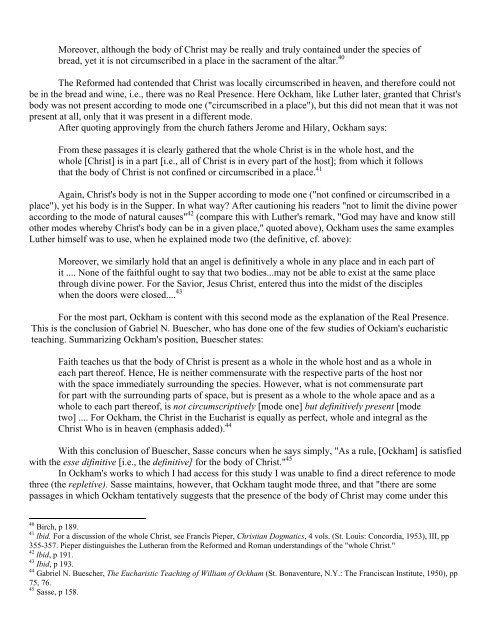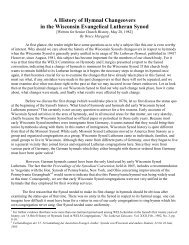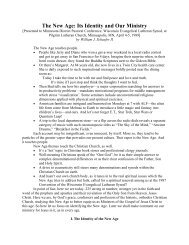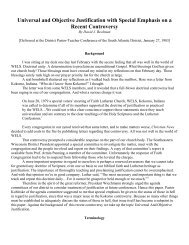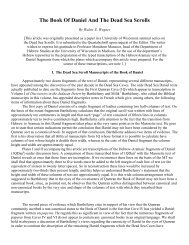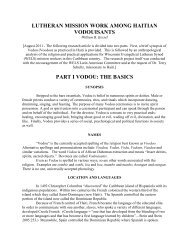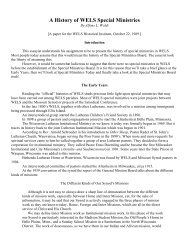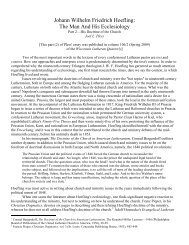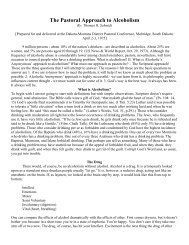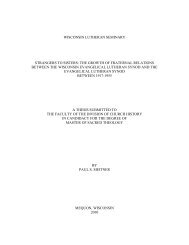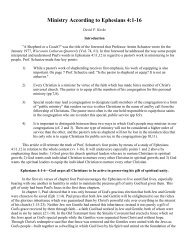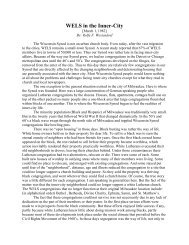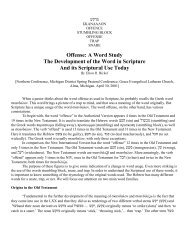the influence of william of ockham on luther's eucharistic theology
the influence of william of ockham on luther's eucharistic theology
the influence of william of ockham on luther's eucharistic theology
You also want an ePaper? Increase the reach of your titles
YUMPU automatically turns print PDFs into web optimized ePapers that Google loves.
Moreover, although <str<strong>on</strong>g>the</str<strong>on</strong>g> body <str<strong>on</strong>g>of</str<strong>on</strong>g> Christ may be really and truly c<strong>on</strong>tained under <str<strong>on</strong>g>the</str<strong>on</strong>g> species <str<strong>on</strong>g>of</str<strong>on</strong>g><br />
bread, yet it is not circumscribed in a place in <str<strong>on</strong>g>the</str<strong>on</strong>g> sacrament <str<strong>on</strong>g>of</str<strong>on</strong>g> <str<strong>on</strong>g>the</str<strong>on</strong>g> altar. 40<br />
The Reformed had c<strong>on</strong>tended that Christ was locally circumscribed in heaven, and <str<strong>on</strong>g>the</str<strong>on</strong>g>refore could not<br />
be in <str<strong>on</strong>g>the</str<strong>on</strong>g> bread and wine, i.e., <str<strong>on</strong>g>the</str<strong>on</strong>g>re was no Real Presence. Here Ockham, like Lu<str<strong>on</strong>g>the</str<strong>on</strong>g>r later, granted that Christ's<br />
body was not present according to mode <strong>on</strong>e ("circumscribed in a place"), but this did not mean that it was not<br />
present at all, <strong>on</strong>ly that it was present in a different mode.<br />
After quoting approvingly from <str<strong>on</strong>g>the</str<strong>on</strong>g> church fa<str<strong>on</strong>g>the</str<strong>on</strong>g>rs Jerome and Hilary, Ockham says:<br />
From <str<strong>on</strong>g>the</str<strong>on</strong>g>se passages it is clearly ga<str<strong>on</strong>g>the</str<strong>on</strong>g>red that <str<strong>on</strong>g>the</str<strong>on</strong>g> whole Christ is in <str<strong>on</strong>g>the</str<strong>on</strong>g> whole host, and <str<strong>on</strong>g>the</str<strong>on</strong>g><br />
whole [Christ] is in a part [i.e., all <str<strong>on</strong>g>of</str<strong>on</strong>g> Christ is in every part <str<strong>on</strong>g>of</str<strong>on</strong>g> <str<strong>on</strong>g>the</str<strong>on</strong>g> host]; from which it follows<br />
that <str<strong>on</strong>g>the</str<strong>on</strong>g> body <str<strong>on</strong>g>of</str<strong>on</strong>g> Christ is not c<strong>on</strong>fined or circumscribed in a place. 41<br />
Again, Christ's body is not in <str<strong>on</strong>g>the</str<strong>on</strong>g> Supper according to mode <strong>on</strong>e ("not c<strong>on</strong>fined or circumscribed in a<br />
place"), yet his body is in <str<strong>on</strong>g>the</str<strong>on</strong>g> Supper. In what way? After cauti<strong>on</strong>ing his readers "not to limit <str<strong>on</strong>g>the</str<strong>on</strong>g> divine power<br />
according to <str<strong>on</strong>g>the</str<strong>on</strong>g> mode <str<strong>on</strong>g>of</str<strong>on</strong>g> natural causes" 42 (compare this with Lu<str<strong>on</strong>g>the</str<strong>on</strong>g>r's remark, "God may have and know still<br />
o<str<strong>on</strong>g>the</str<strong>on</strong>g>r modes whereby Christ's body can be in a given place," quoted above), Ockham uses <str<strong>on</strong>g>the</str<strong>on</strong>g> same examples<br />
Lu<str<strong>on</strong>g>the</str<strong>on</strong>g>r himself was to use, when he explained mode two (<str<strong>on</strong>g>the</str<strong>on</strong>g> definitive, cf. above):<br />
Moreover, we similarly hold that an angel is definitively a whole in any place and in each part <str<strong>on</strong>g>of</str<strong>on</strong>g><br />
it .... N<strong>on</strong>e <str<strong>on</strong>g>of</str<strong>on</strong>g> <str<strong>on</strong>g>the</str<strong>on</strong>g> faithful ought to say that two bodies...may not be able to exist at <str<strong>on</strong>g>the</str<strong>on</strong>g> same place<br />
through divine power. For <str<strong>on</strong>g>the</str<strong>on</strong>g> Savior, Jesus Christ, entered thus into <str<strong>on</strong>g>the</str<strong>on</strong>g> midst <str<strong>on</strong>g>of</str<strong>on</strong>g> <str<strong>on</strong>g>the</str<strong>on</strong>g> disciples<br />
when <str<strong>on</strong>g>the</str<strong>on</strong>g> doors were closed.... 43<br />
For <str<strong>on</strong>g>the</str<strong>on</strong>g> most part, Ockham is c<strong>on</strong>tent with this sec<strong>on</strong>d mode as <str<strong>on</strong>g>the</str<strong>on</strong>g> explanati<strong>on</strong> <str<strong>on</strong>g>of</str<strong>on</strong>g> <str<strong>on</strong>g>the</str<strong>on</strong>g> Real Presence.<br />
This is <str<strong>on</strong>g>the</str<strong>on</strong>g> c<strong>on</strong>clusi<strong>on</strong> <str<strong>on</strong>g>of</str<strong>on</strong>g> Gabriel N. Buescher, who has d<strong>on</strong>e <strong>on</strong>e <str<strong>on</strong>g>of</str<strong>on</strong>g> <str<strong>on</strong>g>the</str<strong>on</strong>g> few studies <str<strong>on</strong>g>of</str<strong>on</strong>g> Ockiam's <strong>eucharistic</strong><br />
teaching. Summarizing Ockham's positi<strong>on</strong>, Buescher states:<br />
Faith teaches us that <str<strong>on</strong>g>the</str<strong>on</strong>g> body <str<strong>on</strong>g>of</str<strong>on</strong>g> Christ is present as a whole in <str<strong>on</strong>g>the</str<strong>on</strong>g> whole host and as a whole in<br />
each part <str<strong>on</strong>g>the</str<strong>on</strong>g>re<str<strong>on</strong>g>of</str<strong>on</strong>g>. Hence, He is nei<str<strong>on</strong>g>the</str<strong>on</strong>g>r commensurate with <str<strong>on</strong>g>the</str<strong>on</strong>g> respective parts <str<strong>on</strong>g>of</str<strong>on</strong>g> <str<strong>on</strong>g>the</str<strong>on</strong>g> host nor<br />
with <str<strong>on</strong>g>the</str<strong>on</strong>g> space immediately surrounding <str<strong>on</strong>g>the</str<strong>on</strong>g> species. However, what is not commensurate part<br />
for part with <str<strong>on</strong>g>the</str<strong>on</strong>g> surrounding parts <str<strong>on</strong>g>of</str<strong>on</strong>g> space, but is present as a whole to <str<strong>on</strong>g>the</str<strong>on</strong>g> whole apace and as a<br />
whole to each part <str<strong>on</strong>g>the</str<strong>on</strong>g>re<str<strong>on</strong>g>of</str<strong>on</strong>g>, is not circumscriptively [mode <strong>on</strong>e] but definitively present [mode<br />
two] .... For Ockham, <str<strong>on</strong>g>the</str<strong>on</strong>g> Christ in <str<strong>on</strong>g>the</str<strong>on</strong>g> Eucharist is equally as perfect, whole and integral as <str<strong>on</strong>g>the</str<strong>on</strong>g><br />
Christ Who is in heaven (emphasis added). 44<br />
With this c<strong>on</strong>clusi<strong>on</strong> <str<strong>on</strong>g>of</str<strong>on</strong>g> Buescher, Sasse c<strong>on</strong>curs when he says simply, "As a rule, [Ockham] is satisfied<br />
with <str<strong>on</strong>g>the</str<strong>on</strong>g> esse difinitive [i.e., <str<strong>on</strong>g>the</str<strong>on</strong>g> definitive] for <str<strong>on</strong>g>the</str<strong>on</strong>g> body <str<strong>on</strong>g>of</str<strong>on</strong>g> Christ." 45<br />
In Ockham's works to which I had access for this study I was unable to find a direct reference to mode<br />
three (<str<strong>on</strong>g>the</str<strong>on</strong>g> repletive). Sasse maintains, however, that Ockham taught mode three, and that "<str<strong>on</strong>g>the</str<strong>on</strong>g>re are some<br />
passages in which Ockham tentatively suggests that <str<strong>on</strong>g>the</str<strong>on</strong>g> presence <str<strong>on</strong>g>of</str<strong>on</strong>g> <str<strong>on</strong>g>the</str<strong>on</strong>g> body <str<strong>on</strong>g>of</str<strong>on</strong>g> Christ may come under this<br />
40 Birch, p 189.<br />
41 lbid. For a discussi<strong>on</strong> <str<strong>on</strong>g>of</str<strong>on</strong>g> <str<strong>on</strong>g>the</str<strong>on</strong>g> whole Christ, see Francis Pieper, Christian Dogmatics, 4 vols. (St. Louis: C<strong>on</strong>cordia, 1953), III, pp<br />
355-357. Pieper distinguishes <str<strong>on</strong>g>the</str<strong>on</strong>g> Lu<str<strong>on</strong>g>the</str<strong>on</strong>g>ran from <str<strong>on</strong>g>the</str<strong>on</strong>g> Reformed and Roman understandings <str<strong>on</strong>g>of</str<strong>on</strong>g> <str<strong>on</strong>g>the</str<strong>on</strong>g> "whole Christ."<br />
42 lbid, p 191.<br />
43 Ibid, p 193.<br />
44 Gabriel N. Buescher, The Eucharistic Teaching <str<strong>on</strong>g>of</str<strong>on</strong>g> William <str<strong>on</strong>g>of</str<strong>on</strong>g> Ockham (St. B<strong>on</strong>aventure, N.Y.: The Franciscan Institute, 1950), pp<br />
75, 76.<br />
45 Sasse, p 158.


